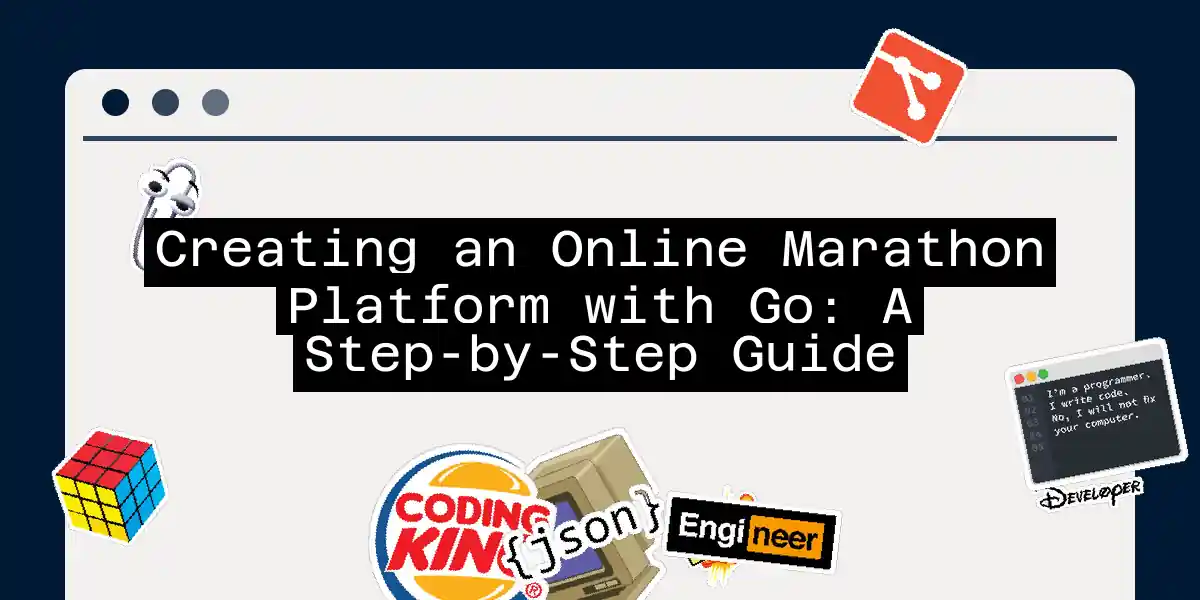Introduction to Go and Its Benefits
Before diving into the nitty-gritty of creating an online marathon platform, let’s briefly discuss why Go (also known as Golang) is an excellent choice for this task. Go, developed by Google, is designed to handle the challenges of building scalable and high-performance applications. Here are some key benefits that make Go a great fit for our project:
- High Performance: Go compiles to machine code, ensuring fast execution speeds. This is crucial for handling a large number of concurrent requests, which is typical in online marathon platforms.
- Simple Syntax: Go’s minimalist syntax makes it easy to learn and use, reducing the likelihood of errors and allowing developers to start coding quickly.
- Built-in Concurrency Support: Go provides convenient mechanisms for handling parallel tasks, such as goroutines and channels, which are essential for managing multiple simultaneous requests.
- Static Typing: Go’s strict type system helps avoid many errors at the compilation stage, making the code more reliable and easier to maintain.
Setting Up the Environment
To start developing your online marathon platform, you need to set up your Go environment. Here are the steps:
Install Go:
- Download the Go installer from the official Go website and follow the installation instructions.
- Verify the installation by running
go versionin your terminal.
Set Up Your IDE:
- Choose an Integrated Development Environment (IDE) like Visual Studio Code, IntelliJ IDEA, or Sublime Text.
- Install the Go extension for your chosen IDE to get syntax highlighting, code completion, and debugging support.
Initialize Your Project:
- Create a new directory for your project and navigate to it in your terminal.
- Initialize a new Go module by running
go mod init marathon-platform.
Creating the Basic Structure
Let’s create a basic structure for our online marathon platform. We’ll need the following components:
- Main Function: The entry point of our application.
- Router: To handle different routes and HTTP requests.
- Database: To store and retrieve data about marathons, users, and other relevant information.
Here’s a simple example to get you started:
package main
import (
"fmt"
"log"
"net/http"
"github.com/gorilla/mux"
)
func main() {
router := mux.NewRouter()
router.HandleFunc("/marathons", getMarathons).Methods("GET")
router.HandleFunc("/marathons/{id}", getMarathon).Methods("GET")
router.HandleFunc("/marathons", createMarathon).Methods("POST")
fmt.Println("Starting server on port 8000")
log.Fatal(http.ListenAndServe(":8000", router))
}
func getMarathons(w http.ResponseWriter, r *http.Request) {
// Implement logic to retrieve marathons from the database
fmt.Fprint(w, "Marathons list")
}
func getMarathon(w http.ResponseWriter, r *http.Request) {
vars := mux.Vars(r)
id := vars["id"]
// Implement logic to retrieve a specific marathon from the database
fmt.Fprint(w, "Marathon details for ID: ", id)
}
func createMarathon(w http.ResponseWriter, r *http.Request) {
// Implement logic to create a new marathon in the database
fmt.Fprint(w, "Marathon created successfully")
}
Database Integration
For a real-world application, you’ll need to integrate a database to store and retrieve data. Let’s use PostgreSQL as an example.
Install the PostgreSQL Driver:
go get github.com/lib/pqConnect to the Database:
import ( "database/sql" "fmt" _ "github.com/lib/pq" ) func connectToDB() *sql.DB { connStr := "user=myuser dbname=mydb sslmode=disable" db, err := sql.Open("postgres", connStr) if err != nil { log.Fatal(err) } return db }Create Tables and Perform CRUD Operations:
func createTables(db *sql.DB) { _, err := db.Exec(` CREATE TABLE IF NOT EXISTS marathons ( id SERIAL PRIMARY KEY, name VARCHAR(255) NOT NULL, start_date DATE NOT NULL, end_date DATE NOT NULL ); `) if err != nil { log.Fatal(err) } } func getMarathons(db *sql.DB) { rows, err := db.Query("SELECT * FROM marathons") if err != nil { log.Fatal(err) } defer rows.Close() for rows.Next() { var ( id int name string startDate time.Time endDate time.Time ) err = rows.Scan(&id, &name, &startDate, &endDate) if err != nil { log.Fatal(err) } fmt.Printf("ID: %d, Name: %s, Start Date: %v, End Date: %v\n", id, name, startDate, endDate) } }
Handling Concurrency
Go’s concurrency features are one of its strongest points. Here’s how you can use goroutines and channels to handle concurrent requests:
package main
import (
"fmt"
"sync"
)
func handleRequest(wg *sync.WaitGroup, id int) {
defer wg.Done()
fmt.Printf("Handling request for ID: %d\n", id)
// Simulate some work
time.Sleep(2 * time.Second)
}
func main() {
var wg sync.WaitGroup
for i := 1; i <= 10; i++ {
wg.Add(1)
go handleRequest(&wg, i)
}
wg.Wait()
fmt.Println("All requests handled")
}
Sequence Diagram for Request Handling
Here’s a sequence diagram showing how requests are handled concurrently:
Testing and Deployment
Testing and deployment are crucial steps in the development lifecycle. Here’s how you can test your application and deploy it:
Testing:
- Use Go’s built-in
testingpackage to write unit tests and integration tests. - Example:
package main import ( "net/http" "net/http/httptest" "testing" ) func TestGetMarathons(t *testing.T) { req, err := http.NewRequest("GET", "/marathons", nil) if err != nil { t.Fatal(err) } w := httptest.NewRecorder() router := mux.NewRouter() router.HandleFunc("/marathons", getMarathons).Methods("GET") router.ServeHTTP(w, req) if w.Code != http.StatusOK { t.Errorf("Expected status code %d but got %d", http.StatusOK, w.Code) } }
- Use Go’s built-in
Deployment:
- Use Docker to containerize your application.
- Example
Dockerfile:FROM golang:alpine WORKDIR /app COPY go.mod go.sum ./ RUN go mod download COPY . . RUN go build -o main . EXPOSE 8000 CMD ["./main"]
Deploy to Cloud Platforms:
- You can deploy your Dockerized application to cloud platforms like AWS, Google Cloud, or Azure.
- Example using AWS ECS:
aws ecs create-cluster --cluster-name marathon-platform aws ecs create-task-definition --family marathon-platform --requires-compatibilities EC2 --network-mode awsvpc --cpu 1024 --memory 512 --container-definitions '[{"name":"marathon-platform","image":"<your-docker-image>","portMappings":[{"containerPort":8000,"hostPort":8000,"protocol":"tcp"}]}]' aws ecs create-service --cluster marathon-platform --service-name marathon-platform --task-definition marathon-platform --desired-count 1 --launch-type EC2 --network-configuration 'AwsVpcConfiguration={Subnets=["<your-subnet-id>"],SecurityGroups=["<your-security-group-id>"],AssignPublicIp="ENABLED"}'
Conclusion
Creating an online marathon platform with Go involves several steps, from setting up the environment to deploying the application. Go’s high performance, simple syntax, and built-in concurrency support make it an ideal choice for such projects. By following the steps outlined above, you can build a robust and scalable platform to host online marathons.
Remember, practice makes perfect. Keep experimenting with different features and technologies to enhance your skills and create more complex and functional applications. Happy coding 🚀
